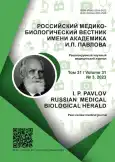The Role of Inflammatory Biomarkers of Crevicular Fluid Involved in Modulating of Immune Protection Mechanisms in Chronic Periodontitis
- Authors: Galieva A.S.1, Davidovich N.V.1, Opravin A.S.1, Khar'kova O.A.1, Polivanaya E.A.1, Bazhukova T.A.1
-
Affiliations:
- Northern State Medical University
- Issue: Vol 31, No 3 (2023)
- Pages: 451-458
- Section: Original study
- Submitted: 09.03.2023
- Accepted: 13.04.2023
- Published: 12.10.2023
- URL: https://journals.eco-vector.com/pavlovj/article/view/321217
- DOI: https://doi.org/10.17816/PAVLOVJ321217
- ID: 321217
Cite item
Abstract
INTRODUCTION: Chronic periodontal inflammation is provoked by persistence of subgingival bacterial flora and is mediated through the production of proinflammatory cytokines that induce the innate immune reactions.
АIM: To establish the interrelation of secretion of interleukin 1ß and immune component of soluble CD14 co-receptor with the main periodontopathogenic microorganisms in patients with chronic generalized periodontitis.
MATERIALS AND METHODS: A clinical and laboratory examination of patients with chronic generalized periodontitis (n = 100) and individuals with the intact parodontium (n = 63) was conducted. Molecular genetic studies (isolation of periodontal pathogens by polymerase chain reaction in real time), immune enzyme assay (isolation of interleukin 1ß and soluble CD14 co-receptor) and statistical analysis of the data obtained were performed.
RESULTS: The frequency of isolation of periodontopathogenic bacteria in patients with the diagnosis of chronic periodontitis was 96.4% (T. forsythia — 81%, р < 0.001; P. gingivalis — 69%, р < 0.001; Tr. denticola — 63%, р = 0.054). In 25% of cases, C. Albicans (р < 0.001), in 37% — Pr. intermedia (р < 0.001) and in 30% — A. actinomycetemcomitans (р < 0.001) were isolated. The average concentrations of soluble CD14 co-receptor were 2.13 [1.89; 2.76] pg/ml in the control group and 20.3 [17.3; 22.5] ng/ml in the group of patients with chronic periodontitis (р < 0.001). Concentrations of interleukin 1ß were 3.187 [2.356; 4.633] pg/ml in the control group and 33.68 [17.255; 56.915] pg/ml in the group of patients with chronic periodontitis (р < 0.001).
CONCLUSION: Inflammation of periodontal tissues is supported by the factors of aggression and toxins not only of known periodontal pathogens, but also by their associations, which leads to enhancement of virulence factors and increase in secretion of interleukin 1ß and soluble CD14 co-receptor, which, in turn, causes destruction of alveolar bone.
Full Text
About the authors
Aleksandra S. Galieva
Northern State Medical University
Author for correspondence.
Email: alexgalieva@yandex.ru
ORCID iD: 0000-0002-7037-7730
SPIN-code: 3054-9139
Russian Federation, Arkhangelsk
Nataliya V. Davidovich
Northern State Medical University
Email: nvdavidovich@gmail.com
ORCID iD: 0000-0002-6414-9870
SPIN-code: 5230-2125
MD, Cand. Sci. (Med.), Associate Professor
Russian Federation, ArkhangelskAleksandr S. Opravin
Northern State Medical University
Email: opravinas@nsmu.ru
ORCID iD: 0000-0002-0057-3357
SPIN-code: 7270-2960
MD, Dr. Sci. (Med.)
Russian Federation, ArkhangelskOl'ga A. Khar'kova
Northern State Medical University
Email: harkovaolga@yandex.ru
ORCID iD: 0000-0002-3130-2920
SPIN-code: 2167-7550
Cand. Sci. (Psychol.)
Russian Federation, ArkhangelskElena A. Polivanaya
Northern State Medical University
Email: poliana.doc@mail.ru
ORCID iD: 0000-0001-6813-453X
SPIN-code: 2004-4892
MD, Cand. Sci. (Med.)
Russian Federation, ArkhangelskTat'yana A. Bazhukova
Northern State Medical University
Email: tbazhukova@yandex.ru
ORCID iD: 0000-0002-7890-2341
SPIN-code: 2220-2151
MD, Dr. Sci. (Med.), Professor
Russian Federation, ArkhangelskReferences
- Tsimbalistov АV, Natsvlishvili TT, Kadurina TI, et al. Сharacteristics of periodontal pocket microorganisms in aggressive periodontitis. The Dental Institute. 2010;(4):73–5. (In Russ).
- Na HS, Kim SY, Han H, et al. Identification of Potential Oral Microbial Biomarkers for the Diagnosis of Periodontitis. J Clin Med. 2020;9(5):1549. doi: 10.3390/jcm9051549
- Tsepov LM, Goleva NA. Role of microbial flora in the development of inflammatory periodontal diseases. Parodontologiya. 2009;(1):7–12. (In Russ).
- Fleysher GM. Gigiyena polosti rta. Moscow: Izdatel’skiye resheniya; 2019. (In Russ).
- Balmasova IP, Tsarev VN, Yanushevich OO, et al. Mikroekologiya parodonta. Vzaimosvyaz’ lokal’nykh i sistemnykh effektov. Moscow: Prakticheskaya meditsina; 2021. (In Russ).
- Lamont RJ, Jenkinson HF. Subgingival colonization by Porphyromonas gingivalis. Oral Microbiol Immunol. 2000;15(6):341–9. doi: 10.1034/j.1399-302x.2000.150601.x
- Mysak J, Podzimek S, Sommerova P, et al. Porphyromonas gingivalis: major periodontopathic pathogen overview. J Immunol Res. 2014;2014:476068. doi: 10.1155/2014/476068
- Davidovich NV, Galieva AS, Opravin AS, et al. Correlation of marker periodontopathogenic bacteria with the immune component sCD14 secretion level in inflammatory periodontal diseases. Klinicheskaya Laboratornaya Diagnostika (Russian Clinical Laboratory Diagnostics). 2022;67(8):471–5. (In Russ). doi: 10.51620/0869-2084-2022-67-8-471-475
- Murakami T, Takahata Y, Hata K, et al. Role of interleukin-1 and inflammasomes in oral disease. J Oral Biosci. 2020;62(3):242–8. doi: 10.1016/j.job.2020.07.003
- Tsarev VN, Nikolaeva EN, Ippolitov EV. Periodontophatogenic bacteria of the main factors of emergence and development of periodontitis. Journal of Microbiology, Epidemiology and Immunobiology. 2017;94(5):101–12. (In Russ). doi: 10.36233/0372-9311-2017-5-101-112
- Xu W, Zhou W, Wang H, et al. Roles of Porphyromonas gingivalis and its virulence factors in periodontitis. Adv Protein Chem Struct Biol. 2020;120:45–84. doi: 10.1016/bs.apcsb.2019.12.001
Supplementary files










